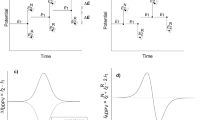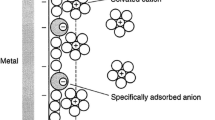Appendix
In order to solve the differential equation (14) system, we define two new variables:
$$ {u}_{\mathrm{AT}}=\frac{c_{\mathrm{AT}}r}{c_{\mathrm{AT}}^{*}{r}_0}\kern0.5em ;\kern0.5em {u}_{\mathrm{BT}}=\frac{c_{\mathrm{BT}}r}{c_{\mathrm{AT}}^{*}{r}_0} $$
(47)
so that the differential equation system and the boundary value problem become:
$$ \left\{\begin{array}{l}\frac{\partial {u}_{\mathrm{AT}}}{\partial t}={D}_{\mathrm{eff}}\frac{\partial^2{u}_{\mathrm{AT}}}{\partial {r}^2}\\ {}\frac{\partial {u}_{\mathrm{BT}}}{\partial t}={D}_{\mathrm{eff}}^{\prime}\frac{\partial^2{u}_{\mathrm{BT}}}{\partial {r}^2}\end{array}\right. $$
(48)
$$ \begin{array}{ll}\left.\begin{array}{l}r\ge {r}_0,t=0\hfill \\ {}r\to \infty, t\ge 0\hfill \end{array}\right\}\hfill & {u}_{\mathrm{AT}}=\frac{r}{r_0};\kern0.5em {u}_{\mathrm{BT}}=0\hfill \\ {}\left.r={r}_0,t>0\right\}\hfill & \hfill \end{array} $$
(49)
$$ {D}_{\mathrm{eff}}\left[{\left(\frac{\partial {u}_{\mathrm{AT}}}{\partial r}\right)}_{r={r}_0}-\frac{u_{\mathrm{AT}}\left({r}_0\right)}{r_0}\right]=-{D}_{\mathrm{eff}}^{\prime}\left[{\left(\frac{\partial {u}_{\mathrm{BT}}}{\partial r}\right)}_{r={r}_0}-\frac{u_{\mathrm{BT}}\left({r}_0\right)}{r_0}\right] $$
(50)
$$ {u}_{\mathrm{AT}}\left({r}_0\right)={u}_{\mathrm{BT}}\left({r}_0\right){e}^{\eta^{\prime }} $$
(51)
The above problem will be solved by means of Koutecký’s dimensionless parameter method. With this aim, the following dimensionless variables are defined:
$$ s=\frac{r-{r}_0}{2\sqrt{D_{\mathrm{eff}}t}};\kern0.96em {s}^{\prime }=\frac{r-{r}_0}{2\sqrt{D_{\mathrm{eff}}^{\prime }t}} $$
(52)
$$ \xi =\frac{2\sqrt{D_{\mathrm{eff}}^{\prime }t}}{r_0} $$
(53)
so that introducing them into Eqs. (48)–(51):
$$ \left\{\begin{array}{l}\frac{\partial^2{u}_{\mathrm{AT}}}{\partial {s}^2}+2s\frac{\partial {u}_{\mathrm{AT}}}{\partial s}-2\xi \frac{\partial {u}_{\mathrm{AT}}}{\partial \xi }=0\\ {}\frac{\partial^2{u}_{\mathrm{BT}}}{\partial {s^{\prime}}^2}+2{s}^{\prime}\frac{\partial {u}_{\mathrm{BT}}}{\partial {s}^{\prime }}-2\xi \frac{\partial {u}_{\mathrm{BT}}}{\partial \xi }=0\end{array}\right. $$
(54)
$$ \begin{array}{l}\left.s,{s}^{\prime}\to \infty \right\}\kern0.75em {u}_{\mathrm{AT}}=1+\gamma \xi s;\ {u}_{\mathrm{BT}}=0\hfill \\ {}\left.s,{s}^{\prime}\to 0\right\}\hfill \end{array} $$
(55)
$$ \gamma {\left(\frac{\partial {u}_{\mathrm{AT}}}{\partial s}\right)}_{s=0}-\xi {\gamma}^2{u}_{\mathrm{AT}}\left(s=0\right)=-{\left(\frac{\partial {u}_{\mathrm{BT}}}{\partial {s}^{\prime }}\right)}_{s^{\prime }=0}+\xi {u}_{\mathrm{BT}}\left({s}^{\prime }=0\right) $$
(56)
$$ {u}_{\mathrm{AT}}\left(s=0\right)={u}_{\mathrm{BT}}\left({s}^{\prime }=0\right){e}^{\eta^{\prime }} $$
(57)
with
$$ \gamma =\sqrt{\frac{D_{\mathrm{eff}}}{D_{\mathrm{eff}}^{\prime }}} $$
(58)
According to Koutecký’s method, the solutions of system (54) are supposed to be functional series as follows:
$$ \left\{\begin{array}{l}{u}_{\mathrm{AT}}\left(s,\xi \right)={\displaystyle \sum_{j=0}^{\infty }{\sigma}_j(s){\xi}^j}\\ {}{u}_{\mathrm{BT}}\left({s}^{\hbox{'}},\xi \right)={\displaystyle \sum_{j=0}^{\infty }{\phi}_j\left({s}^{\hbox{'}}\right){\xi}^j}\end{array}\right. $$
(59)
with
$$ \left.\begin{array}{l}{\sigma}_j(s)={h}_j{\psi}_j(s)+\frac{\sigma_j\left(s=\infty \right)}{\underset{s\to \infty }{ \lim }{L}_j}{L}_j\\ {}{\phi}_j\left({s}^{\prime}\right)={h}_j^{\prime }{\psi}_j\left({s}^{\prime}\right)+\frac{\phi_j\left({s}^{\hbox{'}}=\infty \right)}{\underset{s^{\prime}\to \infty }{ \lim }{L}_j}{L}_j\end{array}\right\}\forall j $$
(60)
where h
j
and h
′
j
are constants that are determined by application of the boundary value problem and L
j
are numeric series of s potencies. In addition, ψ
j
are Koutecký’s functions that have the following properties:
$$ \left\{\begin{array}{l}{\psi}_j(0)=1\\ {}{\psi}_j\left(\infty \right)=0\\ {}{\psi}_j^{\prime}\left(z>0\right)=-{p}_j{\psi}_{j-1}\left(z>0\right)\kern1.2em \\ {}{\psi}_0^{\prime}\left(z>0\right)=1-erf\left(z>0\right)\kern0.96em \end{array}\right. $$
(61)
with ψ′ being the first derivative. Hence, by introducing expression (59) into Eqs. (54)–(57), one obtains:
$$ \begin{array}{l}\left\{\begin{array}{l}{\sigma}_j^{{\prime\prime} }(s)+2s\;{\sigma}_j^{\prime }(s)-2j{\sigma}_j(s)=0\hfill \\ {}{\phi}_j^{{\prime\prime}}\left({s}^{\prime}\right)+2{s}^{\prime }{\phi}_j^{\prime}\left({s}^{\prime}\right)-2j{\phi}_j\left({s}^{\prime}\right)=0\hfill \end{array}\right.\hfill \\ {}\left.s,{s}^{\prime}\to \infty \right\}\hfill \end{array} $$
(62)
$$ \begin{array}{l}\left\{\begin{array}{l}{\sigma}_0\left(\infty \right)=1;\ {\sigma}_1\left(\infty \right)=\gamma s; \kern0.37em {\sigma}_{j\ge 2}\left(\infty \right)=0\hfill \\ {}{\phi}_{j\ge 0}\left(\infty \right)=0\hfill \end{array}\right.\hfill \\ {}\left.s,{s}^{\prime}\to 0\right\}\hfill \end{array} $$
(63)
$$ \left\{\begin{array}{l}\gamma {\sigma}_0^{\prime }(0)=-{\phi}_0^{\prime }(0)\\ {}\gamma {\sigma}_j^{\prime }(0)-{\gamma}^2{\sigma}_{j-1}(0)=-{\phi}_j^{\prime }(0)+{\phi}_{j-1}(0); \kern0.75em j>0\end{array}\right. $$
(64)
$$ {\sigma}_j(0)={\phi}_j(0){e}^{\eta^{\prime }}\kern0.5em ;\kern0.5em j\ge 0 $$
(65)
where σ
′
j
and ϕ
′
j
are the first derivatives while σ
″
j
and ϕ
″
j
are the second ones. For j = 0, the solutions of system (62) are given by:
$$ \left\{\begin{array}{l}{\sigma}_0(s)={h}_0 erfc(s)+{\sigma}_0\left(s=\infty \right)erf(s)\\ {}{\phi}_0\left({s}^{\prime}\right)={h}_0^{\prime } erfc\left({s}^{\prime}\right)+{\phi}_0\left({s}^{\prime }=\infty \right)erf\left({s}^{\prime}\right)\end{array}\right. $$
(66)
and considering the conditions given in (63):
$$ \left\{\begin{array}{l}{\sigma}_0(s)={h}_0 erfc(s)+erf(s)\\ {}{\phi}_0\left({s}^{\prime}\right)={h}_0^{\prime } erfc\left({s}^{\prime}\right)\end{array}\right. $$
(67)
we can write that:
$$ \left\{\begin{array}{l}{\sigma}_0(0)={h}_0\kern4.56em \\ {}{\phi}_0(0)={h}_0^{\prime}\\ {}{\sigma}_0^{\prime }(0)={p}_0\left(1-{h}_0\right)\\ {}\;{\phi}_0^{\prime }(0)=-{p}_0{h}_0^{\prime}\end{array}\right. $$
(68)
with
$$ {p}_0=\frac{2}{\sqrt{\pi }} $$
(69)
Thus, by introducing Eq. (68) into Eqs. (64) and (65), we obtain that:
$$ {h}_0=\frac{\gamma }{1+\gamma {e}^{\eta^{\prime }}}{e}^{\eta^{\prime }} $$
(70)
$$ {h}_0^{\prime }=\frac{\gamma }{1+\gamma {e}^{\eta^{\prime }}} $$
(71)
For j = 1 and considering conditions (63), we can write that:
$$ \left\{\begin{array}{l}{\sigma}_1(s)={h}_1{\psi}_1(s)+\gamma s\\ {}{\phi}_1\left({s}^{\prime}\right)={h}_1^{\prime }{\psi}_1\left({s}^{\prime}\right)\end{array}\right. $$
(72)
so that, taking into account properties (61), it is fulfilled that:
$$ \left\{\begin{array}{l}{\sigma}_1(0)={h}_1\kern2.76em \\ {}{\phi}_1(0)={h}_1^{\prime}\\ {}{\sigma}_1^{\prime }(0)=\gamma -{h}_1{p}_1\\ {}{\phi}_1^{\prime }(0)=-{h}_1^{\prime }{p}_1\end{array}\right. $$
(73)
with
$$ {p}_i=\frac{2i}{p_{i-1}}\kern0.84em i\ge 1 $$
(74)
By substitution of Eqs. (68) and (73) in conditions (64) and (65), one obtains that:
$$ \left\{\begin{array}{l}{h}_1=\frac{\gamma^2\left(1-{h}_0\right)-{h}_0^{\prime }}{p_1\left(1+\gamma {e}^{\eta \prime}\right)}{e}^{\eta \prime}\\ {}{h}_1^{\prime }=\frac{\gamma^2\left(1-{h}_0\right)-{h}_0^{\prime }}{p_1\left(1+\gamma {e}^{\eta \prime}\right)}\end{array}\right. $$
(75)
and taking into account (70) and (71), it is finally obtained that:
$$ \left\{\begin{array}{l}{h}_1=\frac{\gamma \left(\gamma -1\right){e}^{\eta \prime }}{p_1{\left(1+\gamma {e}^{\eta \prime}\right)}^2}\\ {}{h}_1^{\prime }=\frac{\gamma \left(\gamma -1\right)}{p_1{\left(1+\gamma {e}^{\eta \prime}\right)}^2}\end{array}\right. $$
(76)
Following an analogous procedure to that described above, the form of the coefficients h and h′ for j > 0 can be generalised as:
$$ \left\{\begin{array}{l}{h}_{j>0}=\frac{{\left(-1\right)}^{j+1}\gamma \left(\gamma -1\right){\left(1+{\gamma}^2{e}^{\eta \prime}\right)}^{j-1}}{{\left(1+\gamma {e}^{\eta^{\hbox{'}}}\right)}^{j+1}{\displaystyle \prod_{i=1}^j{p}_i}}{e}^{\eta \prime}\\ {}{h}_{j>0}^{\prime }=\frac{{\left(-1\right)}^{j+1}\gamma \left(\gamma -1\right){\left(1+{\gamma}^2{e}^{\eta^{\hbox{'}}}\right)}^{j-1}}{{\left(1+\gamma {e}^{\eta \prime}\right)}^{j+1}{\displaystyle \prod_{i=1}^j{p}_i}}\end{array}\right. $$
(77)
such that the coefficients of the solutions (59) are given by:
$$ \left\{\begin{array}{l}{\sigma}_0(s)=\frac{\gamma }{1+\gamma {e}^{\eta \prime }}{e}^{\eta \prime } erfc(s)+erf(s)\\ {}{\phi}_0\left(s^{\prime}\right)=\frac{\gamma }{1+\gamma {e}^{\eta \prime }} erfc\left(s^{\prime}\right)\end{array}\right. $$
(78)
$$ \left\{\begin{array}{l}{\sigma}_1(s)=\frac{\gamma \left(\gamma -1\right){e}^{\eta \prime }}{p_1{\left(1+\gamma {e}^{\eta \prime}\right)}^2}{\psi}_1(s)+\gamma s\\ {}{\phi}_1\left(s^{\prime}\right)=\frac{\gamma \left(\gamma -1\right)}{p_1{\left(1+\gamma {e}^{\eta \prime}\right)}^2}{\psi}_1\left(s^{\prime}\right)\end{array}\right. $$
(79)
$$ \left\{\begin{array}{l}{\sigma}_{j>1}(s)=\frac{{\left(-1\right)}^{j+1}\gamma \left(\gamma -1\right){\left(1+{\gamma}^2{e}^{\eta \prime}\right)}^{j-1}}{{\left(1+\gamma {e}^{\eta^{\hbox{'}}}\right)}^{j+1}{\displaystyle \prod_{i=1}^j{p}_i}}{e}^{\eta^{\hbox{'}}}{\psi}_j(s)\\ {}{\phi}_{j>1}\left(s^{\prime}\right)=\frac{{\left(-1\right)}^{j+1}\gamma \left(\gamma -1\right){\left(1+{\gamma}^2{e}^{\eta^{\hbox{'}}}\right)}^{j-1}}{{\left(1+\gamma {e}^{\eta \prime}\right)}^{j+1}{\displaystyle \prod_{i=1}^j{p}_i}}{\psi}_j\left(s^{\prime}\right)\end{array}\right. $$
(80)
and by substituting in Eq. (59):
$$ \left\{\begin{array}{l}{u}_{\mathrm{AT}}\left(s,\xi \right)=\frac{\gamma }{1+\gamma {e}^{\eta \prime }}{e}^{\eta \prime } erfc(s)+erf(s)+\gamma s\xi +\gamma \left(\gamma -1\right){e}^{\eta \prime }{\displaystyle \sum_{j=1}^{\infty}\frac{{\left(-1\right)}^{j+1}{\left(1+{\gamma}^2{e}^{\eta \prime}\right)}^{j-1}}{{\left(1+\gamma {e}^{\eta \prime}\right)}^{j+1}{\displaystyle \prod_{i=1}^j{p}_i}}{\xi}^j{\psi}_j(s)}\\ {}\\ {}{u}_{\mathrm{BT}}\left(s^{\prime },\xi \right)=\frac{\gamma }{1+\gamma {e}^{\eta \prime }} erfc\left(s^{\prime}\right)+\gamma \left(\gamma -1\right){\displaystyle \sum_{j=1}^{\infty}\frac{{\left(-1\right)}^{j+1}{\left(1+{\gamma}^2{e}^{\eta \prime}\right)}^{j-1}}{{\left(1+\gamma {e}^{\eta \prime}\right)}^{j+1}{\displaystyle \prod_{i=1}^j{p}_i}}{\xi}^j{\psi}_j\left(s^{\prime}\right)}\end{array}\right. $$
(81)
From the last expression (81), one can deduce that it is convenient to redefine the sphericity dimensionless variable as:
$$ \xi^{\prime }=\frac{\left(1+{\gamma}^2{e}^{\eta \prime}\right)}{\left(1+\gamma {e}^{\eta \prime}\right)}\xi $$
(82)
such that (81) simplifies to:
$$ \left\{\begin{array}{l}{u}_{\mathrm{AT}}\left(s,\xi^{\prime}\right)=\frac{\gamma }{1+\gamma {e}^{\eta \prime }}{e}^{\eta \prime } erfc(s)+erf(s)+\gamma s\frac{\xi^{\prime}\left(1+\gamma {e}^{\eta \prime}\right)}{\left(1+{\gamma}^2{e}^{\eta \prime}\right)}-\frac{\gamma \left(\gamma -1\right){e}^{\eta \prime }}{\left(1+{\gamma}^2{e}^{\eta \prime}\right)\left(1+\gamma {e}^{\eta \prime}\right)}{\displaystyle \sum_{j=1}^{\infty}\frac{{\left(-1\right)}^j{\left(\xi \prime \right)}^j}{{\displaystyle \prod_{i=1}^j{p}_i}}{\psi}_j(s)}\\ {}\\ {}{u}_{\mathrm{BT}}\left(s^{\prime },\xi^{\prime}\right)=\frac{\gamma }{1+\gamma {e}^{\eta \prime }} erfc\left(s^{\prime}\right)-\frac{\gamma \left(\gamma -1\right)}{\left(1+{\gamma}^2{e}^{\eta \prime}\right)\left(1+\gamma {e}^{\eta \prime}\right)}{\displaystyle \sum_{j=1}^{\infty}\frac{{\left(-1\right)}^j{\left(\xi \prime \right)}^j}{{\displaystyle \prod_{i=1}^j{p}_i}}{\psi}_j\left(s^{\prime}\right)}\end{array}\right. $$
(83)
Now, considering the definition of the variables u
AT and u
BT (47) and taking into account (52) and (53), the concentration profiles of the pseudo-species AT (A + AL) and BT (B + BL) are obtained:
$$ {c}_{\mathrm{AT}}\left(s,\xi^{\prime}\right)={c}_{\mathrm{AT}}^{*}-\frac{r_0}{r}\left(\frac{c_{\mathrm{AT}}^{*}}{1+\gamma {e}^{\eta \prime }}\right) erfc(s)-\frac{r_0}{r}\frac{c_{\mathrm{AT}}^{*}\gamma \left(\gamma -1\right){e}^{\eta \prime }}{\left(1+{\gamma}^2{e}^{\eta \prime}\right)\left(1+\gamma {e}^{\eta \prime}\right)}{\displaystyle \sum_{j=1}^{\infty}\frac{{\left(-1\right)}^j{\left(\xi \prime \right)}^j}{{\displaystyle \prod_{i=1}^j{p}_i}}{\psi}_j(s)} $$
(84)
$$ {c}_{\mathrm{BT}}\left(s^{\prime },\xi^{\prime}\right)=\frac{r_0}{r}\left(\frac{c_{\mathrm{AT}}^{*}}{1+\gamma {e}^{\eta \prime }}\right)\gamma erfc\left(s^{\prime}\right)-\frac{r_0}{r}\frac{c_{\mathrm{AT}}^{*}\gamma \left(\gamma -1\right)}{\left(1+{\gamma}^2{e}^{\eta \prime}\right)\left(1+\gamma {e}^{\eta \prime}\right)}{\displaystyle \sum_{j=1}^{\infty}\frac{{\left(-1\right)}^j{\left(\xi \prime \right)}^j}{{\displaystyle \prod_{i=1}^j{p}_i}}{\psi}_j\left(s^{\prime}\right)} $$
(85)










